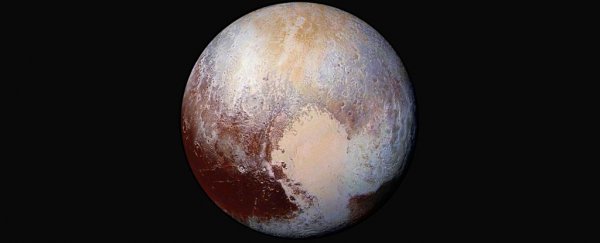Arguably, the single most remarkable thing humanity discovered about Pluto during New Horizon's historic flyby last year was that the dwarf planet had a massive heart.
Not an actual heart, mind you – although, keep reading – but a gigantic heart-shaped region, formed mostly from nitrogen ice.
Now, thanks to a new study, we now know how this region, called Tombaugh Regio, might have come to be.
One thing to understand about Pluto's heart is that it isn't just ice, but a huge formation of glaciers. And the ice in those glaciers is primarily made up of nitrogen, but there's also methane and carbon monoxide in the mix.
But how did all these come together to make the distinctive heart shape the world now knows and loves? Using NASA's New Horizons data and an epic simulation to model Pluto's atmospheric development over the course of some 50,000 years, researchers from the Université Pierre et Marie Curie in France have given us an answer.
"Pluto's surface is an amazing cocktail of different types of ice that do not exist naturally on Earth: nitrogen, methane, and carbon monoxide," lead researcher Tanguy Bertrand told Maarten Rikken at ResearchGate. "We developed a thermal model of Pluto's surface to understand the mechanisms of condensation/sublimation of its ice at a global scale."
The smooth-looking left half of Tombaugh Regio is a 1,000-km-wide plain called Sputnik Planum, and underneath all that ice, this huge expanse is actually a deep basin that extends 4 km downwards.
According to the researchers, that chasm acts as a kind of cold trap, collecting ice into its reaches, and in particular nitrogen and carbon monoxide.
To discover this, the researchers' simulation distributed nitrogen, carbon monoxide, and methane ices a few millimetres thick across the planet. With Pluto's high-and-low topography accounted for as part of the simulation – including the depths of the Sputnik Planum basin and two other significant craters – the researchers sat back and watched as the millennia flew by.
"[W]e discovered that the heart shape is to a large degree created by highly volatile nitrogen ice that unavoidably accumulates in the basin and forms a permanent reservoir of ice, as observed by New Horizons," Bertrand told ResearchGate.
"This happens because of nitrogen's solid-gas equilibrium. At the bottom of the basin the pressure of the atmosphere – and therefore of gaseous nitrogen – is higher, thus the frost temperature is higher than the outside," he added.
"As a result, nitrogen prefers to condense into ice there. Carbon monoxide ice, which is similarly volatile to nitrogen, was also found in be entirely sequestered with nitrogen in the basin."
As for methane ice, it's not restricted to Sputnik Planum, and can be found in a frost that covers both hemispheres of the planet, in addition to its presence in the basin.
The findings, reported in Nature, mean that Pluto wouldn't need a hidden nitrogen reservoir under the surface to feed the Sputnik Planum glacier, as scientists previously thought.
But the new study suggests something even more dramatic might exist on the dwarf planet, thanks to the slow movements in the icy landscape in line with Pluto's seasons. And we do mean slow – one year on Pluto equals 248 Earth years, meaning seasons take several decades to come and go.
But when they do, the deepest, coldest reaches of Sputnik Planum will remain frozen in time, while the shallower areas in and around Tombaugh Regio will allow more gas and ice movement.
The end result, if you were to film a time-lapse video of Pluto over hundreds of years? A beating heart, folks.
"The half heart glacier lying inside is a really massive glacier, which is not impacted by the seasonal changes. It probably formed when the basin formed, and will remain there in the future," Bertrand told Ria Misra at Gizmodo.
"However, it probably flows and retracts over a few hundreds of kilometres (like a heart beating) with time, eroding and shaping the mountains surrounding it."
How awesome. Pluto, our hearts are melting for you too.
Image credit: NASA/Johns Hopkins University Applied Physics Laboratory/Southwest Research Institute
